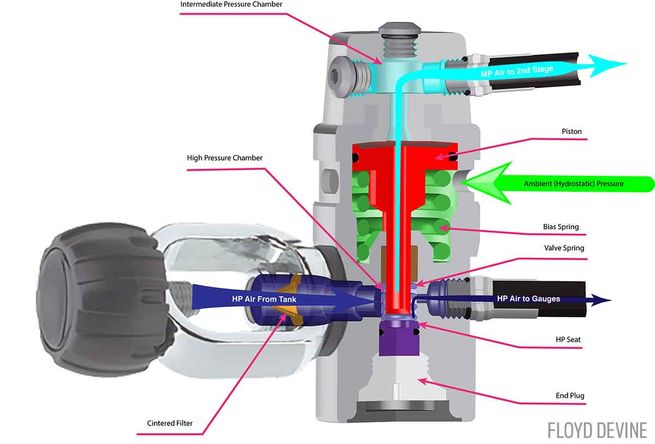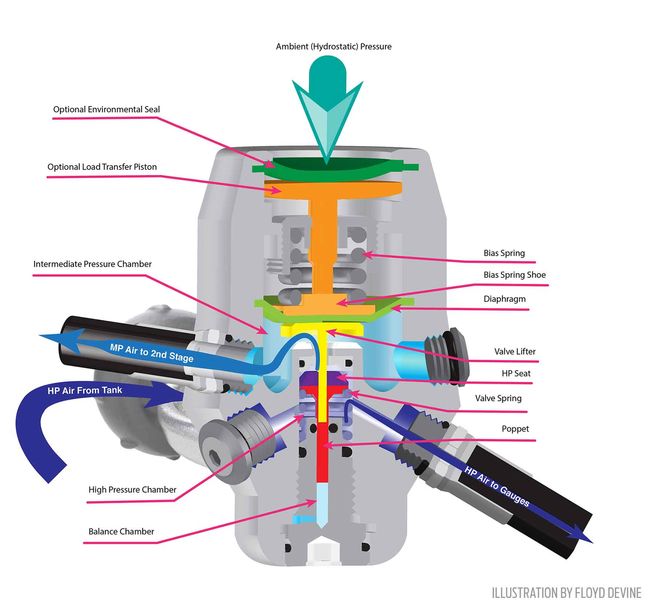The regulator first stage’s major task is to reduce the high tank pressure to an intermediate level that may be used by the second stage and delivered upon demand to the diver. Modern regulator first stages are made with care and built to work under difficult conditions where divers choose to travel.
We’ll look at both piston and diaphragm first stages, as well as their distinctions and links to help you understand how this essential component of equipment allows us to breathe while exploring the ocean’s depths.

Table of Contents
Introduction
A cylinder is connected to a scuba pump via either a DIN or yoke fitting, an intake filter to prevent pollutants from entering the regulator, a regulator body with intermediate- and high-pressure chambers, a bias spring, medium-pressure fittings for second stages, inflator assemblies, and accessories, and high-pressure fittings for gauges.
Piston-style valve assemblies with a high-pressure seat separate the first stage’s high- and intermediate-pressure chambers, whereas diaphragm regulators have a diaphragm, lifter-poppet valve assembly with a high-pressure seat performing the same function.
How It Works
When you breathe in on the second stage of the regulator, pressure in the intermediate chamber drops. The bias spring and ambient water (hydrostatic) pressure push inwards on either side of the diaphragm or piston head, raising the valve and creating a space between the intermediate- and high-pressure chambers.
The high-pressure chamber sends air to the intermediate-pressure chamber through the connecting hose, which is then forced down to the regulator second stage. When the pressure in the intermediate chamber rises until it surpasses that of the bias spring and hydrostatic pressure, the valve closes as a result of the diver’s breathing stopping.
Balanced vs. Unbalanced
The more precise the regulator, the more expensive it is. A balanced regulator has more precision components, therefore costs more. The pressure in the cylinder decreases until it reaches near to intermediate pressure when the temperature inside the cylinder cools down near to intermediate pressure.
The amount of pressure the diver is under has little bearing on your breathability. When the regulator is out of balance as the pressure drops, breathing becomes simpler. The same holds true for deep-diving dives. Whether a second stage or a first stage can be unbalanced is debatable.

Piston vs. Diaphragm
A diaphragm first stage is designed to be environmentally sealed. In cold water, ice particles are considerably less likely to have an impact or cause problems, and silt, abrasions, or other pollutants are also much less probable.Piston regulators are less complicated to make and have a larger volume of air for the second stage because they feature a piston stem that is longer. They are popular owing to their ease of breathing. Diaphragms regulators are more complicated to maintain and have a smaller diameter valve than piston types. Contamination risks may cause pistons to require maintenance of contaminated components, just as with diaphragms. Because of contamination concerns, pistons will be required by regulations.
- The design of a first-stage diaphragm means that it is hermetically sealed.
- Ice particles in cold water are less likely to damage components, and silt, sediment, or other pollutants in turbid waters are less likely to harm them.
- Diaphragm regulators have a smaller diameter valve and more components than piston regulators, making it more difficult to operate.
- Piston regulators are simpler to build and use, and the piston stem diameter allows more air to be supplied to the second stage, making them popular for their simple breathing effort.
- More components are exposed to the elements, making them more vulnerable to contaminants that can cause performance loss, icing in cold water, and free-flow from a stuck piston.
- Because of contamination, piston regulators may require more servicing of exposed components.
Confusing terms
When you’re looking for the finest regulator package, you might come across definitions that you don’t fully grasp. They are aesthetic characteristics that you cannot implement.
First Stage vs. 2nd Stage
The mooring line is connected to the tank of the diver via a yoke or pin. Air pressure is regulated by removing air from the tank prior to it escaping through the hose. A mouthpiece and purged pump are included in the second stage. The purpose of the second stage is to distribute air throughout divers’ mouths and remove any pollutants.
The Bottom Line
The first stages are closed systems, and they do not include user-changeable features. However, the manufacturer may make improvements.
A second diaphragm to protect the bias spring of a diaphragm first stage, or filling the exposed portion of a piston regulator with a viscous fluid and sealing it off with a flexible ring
When the regulator is not connected to a tank, some authorities include automatic devices to cut off the high-pressure intake and prevent pollutants or water from entering the first stage. Some regulators may have a distinct high-performance second stage with an added medium-pressure port with more airflow designed specifically for high-performance second stages.
